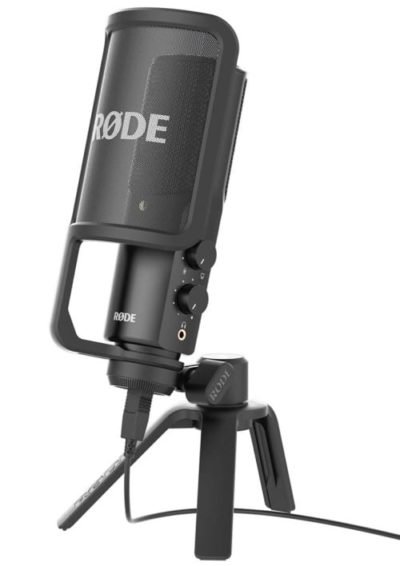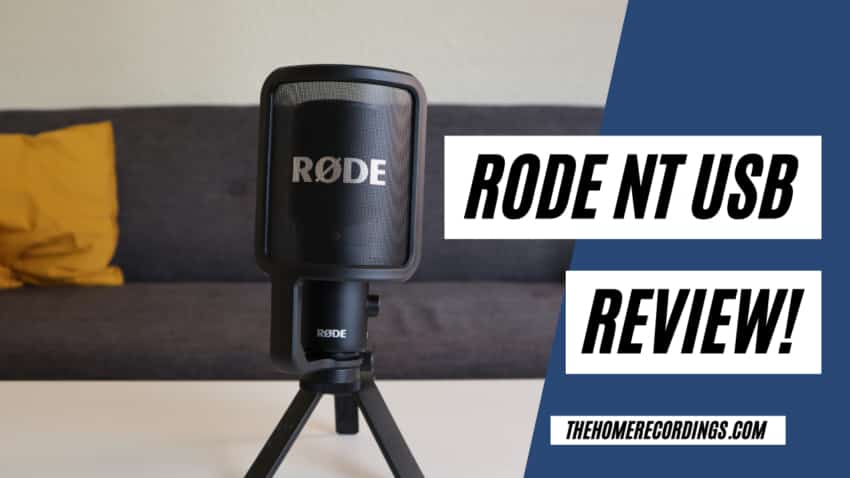Last updated on December 30th, 2023 at 03:50 pm
The Rode NT USB is a microphone that mostly gets praise, be it in videos or just general online reviews.
After testing it for quite some time I think I can give my honest opinion on whether or not it’s worth getting.
As far as the tests I’ve done, they are as follows; I tested how well it rejects background noises, mainly my keyboard, how well it does at recording guitar, both acoustic and electric, and how well it records spoken word.
In this post I will give you a quick overview of the Rode NT USB, as well as my thoughts on how it performs with all it’s pros and cons, and yes… there are a couple cons.
So, don’t buy it before you know what you’re actually getting!
Rode NT USB Overview

The Rode NT USB is a condenser microphone that features a cardioid polar pattern, meaning that it picks up sound from the front and not the back or the sides, and it’s got a frequency response of 20Hz to 20kHz and a sampling rate of 48kHz at 16-bit.
Let’s take a quick look at what you get in the box when purchasing the Rode NT USB:
What comes in the box?
- The Rode NT USB Microphone
- Pop filter
- Microphone stand adapter
- Tripod Desk Stand
- Padded storage pouch
- USB Cable
You may have noticed that when compared to other similarly priced microphones, the Rode NT USB does come with a couple extra items, such as the pop filter and the storage pouch, meaning that you won’t have to spend an extra $20-$30 on those.
The storage pouch is quite good since it’s got some padding to it, and this should help you take care of the mic better.
Additionally, the USB cable is the longest one I’ve ever seen come included with a USB microphone, which is fantastic since I usually have to move my amp closer to the PC when trying out other microphones.
Build Quality
Out of all the USB microphones I’ve tried so far, the build quality of the Rode NT USB is only rivaled by the AT2020 USB, and even then, the Rode has more weight to it and it feels like an absolute tank.
Seriously, it’s really heavy!
It’s got an all-metal body with a metal mesh grille, and no matter how hard I press on any part of the mic, there’s absolutely no give to it.
The knobs are also very well made since they don’t wiggle one bit when turning them, even though I have to say that I don’t like that they decided the put them on the side of the microphone and not the front, but it’s not that big of an issue.
I do however, have a couple complaints about the tripod and the pop filter since they are made of plastic and feel a bit flimsy, especially the tripod.
In fact, I wouldn’t recommend using the tripod at all and to get a boom arm or a conventional tripod.
The reason for this is that the tripod itself isn’t very stable, and since the mic is so heavy, knocking it over accidentally seems quite plausible.
Plus, at least with the tripod I got, it’s not perfectly leveled, and when looking straight at the mic I can see it being slightly tilted to one side, and from an aesthetic standpoint, I don’t like it.
As far as the pop filter goes, even though it’s made of plastic, it does look like it could last you for a very long time. So, even though it could be slightly better made, I don’t have as much on an issue with it as I have with the tripod.
Also, if you’re interested in how this microphone compares to other ones that are around the same price point, check out these articles I wrote;
Knobs and Features
The Rode NT USB only features two knobs and a headphone output on the right side of the microphone.
These two knobs allow you to control the headphone volume and the mix between the computer’s playback and the microphone’s direct sound, also known as zero-latency monitoring.
Basically, when you turn the knob 100% to the left you will only be able to hear what is directly being picked up by the microphone in real time.
Turning it 100% to the right will only let you hear the audio coming from your PC, and you can mix these levels to your liking.
Some microphones, like the Blue Yeti for example, although they may include the zero-latency functionality, don’t have a dedicated knob to control it and you have to adjust it from the OS’s settings, and having this knob right there on the mic is a clear pro.
However, what the Rode NT USB lacks, is a Gain knob…
I have to say, for a USB microphone at this price point, especially considering that it’s made by Rode, not having a Gain knob, forcing you to adjust the levels via the Sound Settings of your PC, seems like a big oversight.
It’s definitely not as bad as it sounds, since it only takes like two seconds to adjust the levels, but I prefer having knobs instead of using my mouse.
Background Noise Rejection
When mounting the microphone on a shock mount and using a boom arm, which is the way I’d recommend you use it, I was able to place it right in front of my mouth, which meant that it was farther away from the keyboard and the noise it picked up wasn’t as noticeable.
However, and this is something that happens with every single microphone that uses a small desk stand/tripod like the one included with the Rode NT USB, when using the included tripod, it picked up a lot more noise, and this happens for two reasons;
Because the microphone is closer to the keyboard, and because the vibrations generated by the keyboard are directly transmitted through the tripod into the mic.
Also, I have to say that the included tripod didn’t really help at absorbing any of those vibrations because it doesn’t have any sort of padding on the bottom.
Recording Quality
I was very pleased with how this microphone performed overall, especially when recording my voice while talking and singing.
The electric guitar on the clean channel had a nice body to it without sounding boomy while at the same time having a defined high-mids and highs section.
The acoustic guitar sounded very open and airy, which I always like.
And lastly, on the overdriven electric guitar -while it took me some time to find a reasonable mic placement-, it sounded full in the bottom end without being too sharp on the highs.
There is one issue however, which is that no matter how much you lower the gain -I literally took it all the way to zero-, the signal will still be quite hot and make recording loud sources difficult since they can easily clip, even when the gain is set to zero.
And this is why I don’t think that this microphone is a good all-rounder, since recording a loud electric guitar cabinet will be near impossible, at least at a level where it’s not dangerously close to clipping.
Note: If you’re recording a cabinet at bedroom levels, it should be more than ok, but I wouldn’t put this mic in front of a fully cranked amp.
Pros
- Extremely Well Built
- Plug n’ Play
- Comes with a Pop Filter
- Fantastic sound quality
Cons
- Weak and unstable tripod
- No Gain knob
- Gain is high even when turned to 0
- No extra features nor software
Here’s a link to Amazon where you can check the current price and reviews of the Rode NT USB. (Affiliate Link)
What I didn’t like about the Rode NT USB
While live monitoring on the headphones, for some reason it always sounded a bit distorted, even when lowering the gain and the headphone volume output, and I don’t know what that’s about.
However, this didn’t happen when playing back sound from the computer no matter the volume (yes, I nearly blew my eardrums out trying to check this), it only happened while listening to the live signal.
Additionally, setting the gain to zero and having it still record at a level where you could talk normally and record a respectable signal is not ideal, since louder sources will clip.
And lastly, not having a gain knob, especially on a microphone in this price range, seems like an intentional design flaw.
What I did like about the Rode NT USB
The build quality is outstanding and so is the recording quality.
Also, the included pop filter does a fantastic job, and if this is your first microphone purchase, it just saves you the trouble of having to get another one.
Overall Thoughts and other alternatives
I have mixed feelings about this microphone, mainly due to the fact that the gain tends to be too high even when set to zero, and people who are considering it not only to use it for voice-related applications but also to record instruments, may have a hard time getting a high-quality signal out of it.
If you’re only going to use it to record your voice, or at least audio sources that aren’t really that loud, then It’s a fantastic microphone since it’s built like a tank, comes with a pop filter, has zero-latency monitoring, sound great, etc.
But if you’re thinking about using it for music purposes as well, then I’d have to advise against it.
One alternative to the Rode NT USB, especially for musicians, would be the Audio-Technica AT2020+ USB; It’s mainly designed to perform well when recording music, it’s also built extremely well, and it doesn’t suffer from the same “high gain” issue.
Important note: The AT2020 USB, just like the Rode, doesn’t come with a gain knob and you will have to adjust this via the sound settings in your PC.
I hope this information was useful!
Have a wonderful day!
